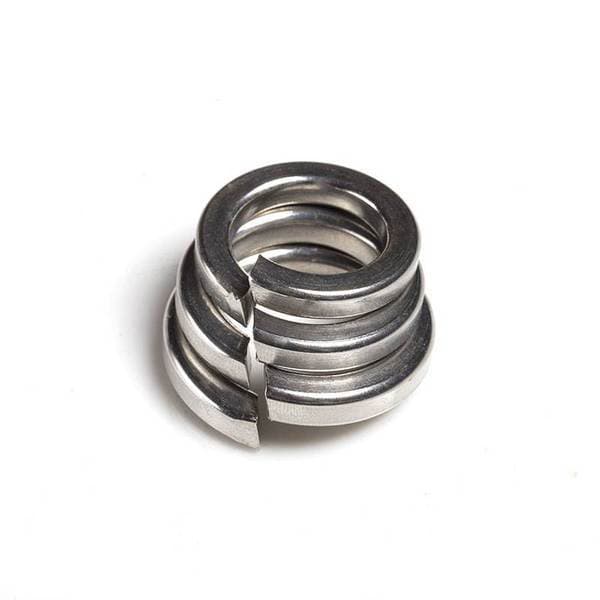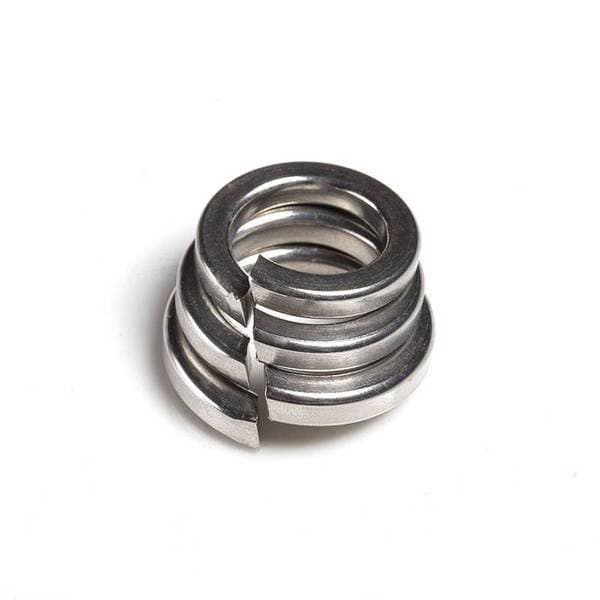
Introduction to Pressure Washers
In the fastener industry, lock washers are commonly called “spring pads” or “spring pads”. They are made from stainless steel or carbon steel (which is essentially iron).
Commonly used sizes for lock washers are M3, M4, M5, M6, M8, M10, M12, M14 and M16. These sizes are widely used in industry. The national standard for spring washers is GB/T 94.1-87, which specifies the standard type of spring washers with sizes ranging from 2 mm to 48 mm.
Main material of pressure washers
Typically made of 65MN spring steel or 70# carbon steel, 3Cr13, materials such as SUS304 or SUS316 stainless steel as well as phosphor bronze can also be used.
Main applications of pressure washers
Lock washers are used to prevent nuts from loosening and this is specified in the national standard.
Hex Slotted Nuts are specifically designed to be used with bolts that have holes in the end so that a cotter pin can be inserted from the nut slot into the bolt hole, preventing the nut from self-loosening. This type of nut is mainly used in situations where there are vibrational or alternating loads.
In mechanical design and manufacturing, there are several methods to prevent nuts (or bolts) from self-loosening:
- Adding Lock Washers (Simple and Easy to Do)
- Using hex nuts with cotter pins (adds extra processing steps)
- Adding anti-loosening washers (adds extra processing steps)
- Inserting a steel wire into the hex head of a hex screw (adds extra processing steps)
Lock washers are commonly used to prevent loosening, for example bolts that connect motors to machine bases often require lock washers because if there is no lock washer the nut will loosen due to vibrations from the motor.
Fasteners on equipment subject to vibrations typically have lock washers installed, while flanges typically do not require washers. Whether or not pressure washers are used on flanges depends on the fluid medium used. If there is a risk of pulsation or if the fluid is flowing at high speeds or if there are frequent diameter changes, spring washers should be used.
It is important to note that this may not apply in all cases as some valves and stuffing box pressure cap flanges may require lock washers. Quick and easy selection of pressure washers is available through the Fastener Expert automated system.
Main differences
Spring washers can prevent loosening and increase preload force, while flat washers do not have this function. Flat washers are used to increase the fastening contact area and prevent friction between screws and parts, protecting the connection surface and avoiding scratches when tightening screws and nuts.
However, for some important connections that rely mainly on compression to transmit frictional force, spring washers cannot be used as they reduce the stiffness of the connection and may cause accidents.
In these cases, flat washers or flange bolts can be used to increase the contact area. When there is vibration, pulsation or large temperature fluctuations in the medium, pressure washers must be used.
Causes of Spring Washer Fracture
- Pressure washers that experience “swelling” are generally not a problem for the pressure washers themselves.
- A spring washer that undergoes swelling has necessarily been subjected to an external radial force, which comes from the axial clamping force produced by the tightening torque.
- The outer chamfer on the nut supporting surface produces a radial splitting force, causing the lock washer opening to widen. The smaller the diameter of the chamfer, the more likely swelling is to occur.
- Placing a flat washer between the nut and lock washer helps slow or prevent swelling, but if the flat washer is too thin or soft, it may not prevent swelling.
- The cause of hydrogen embrittlement fracture in pressure washers is usually due to an irrational heat treatment process or failure to perform hydrogen removal treatment after zinc plating.
Extensive testing and long-term practical experience have confirmed the above analysis.
Classification of pressure washers
Internal tooth spring washer, external tooth spring washer
There are many sharp elastic teeth on the circumference, which pierce the supporting surface and prevent the fastener from loosening. Internal toothed elastic washer is used under the smaller screw head size; external toothed elastic washer is mainly used under the screw head and nut.
The tooth spring washer has a smaller volume than the ordinary spring washer, and the fastener is subjected to uniform force, which can reliably prevent loosening, but is not suitable for frequent disassembly.
Wave Pressure Washer
National Standard: GB/T 7246-1987
Wave pressure washers are divided into WG, WL and WN types.
WG Type Wave Pressure Washer
WG type wave spring washer is an open type spring washer, which can generally be installed in a small space, such as applying preload to bearings, reducing bearing operation noise, improving running accuracy and stability of the bearings. In addition, it is widely used in electronics and household appliances, with materials such as carbon steel, stainless steel and copper alloy.
WL Type Wave Pressure Washer
WL type wave spring washer is a lap joint elastic washer, which can generally be installed in a small space, such as applying preload to bearings, reducing the noise of bearing operation, improving running accuracy and stability of the bearings. In addition, it is widely used in electronics and household appliances, with materials such as carbon steel, stainless steel and copper alloy.
WN Type Wave Pressure Washer
WN type wave pressure washer is a multi-layer wave peak overlapping spring washer. Compared with the WL type, this series is composed of multiple layers of material, so the K value curve under the same compression stroke is flatter than the WL type, which is suitable for situations where the elasticity is higher and the entire working stroke requires uniform release of elasticity. The materials used include carbon steel, stainless steel and copper alloy.
Disc Pressure Washer
The disc pressure washer, also known as the Belleville pressure washer, was invented by the Frenchman Belleville. DIN6796 dish type spring washer (HDS series) is designed for anti-loosening washers for bolt and screw connections.
It is designed and manufactured in accordance with DIN 6796 and is used to connect medium or high strength screws and bolts. The large load bearing and elastic recovery make the HDS series very effective. Bolt tension can withstand relaxation caused by wear of vulnerable parts, creep, relaxation, thermal expansion, shrinkage or tightening of sealing parts.
HDS series increases the elastic effect of screws several times and can effectively replace ordinary spring washers, but is not suitable for use as spring washer or flat washer combination.
Because the HDS series is a disc spring that can be matched or superimposed, matching can increase the deformation of the disc spring group, and overlapping can increase the spring force of the disc spring group.
The ideal installation method is to press it as flat as possible. The closer it is to the flat state, the faster the tightening torque will increase. Proper screw tension can be obtained without a torque wrench.

























































